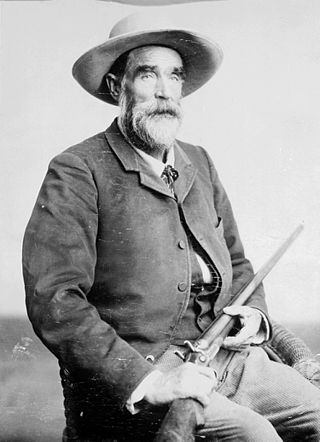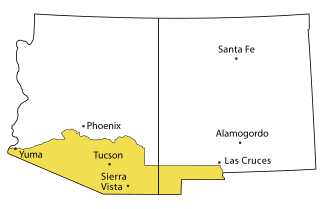
Cochise was leader of the Chihuicahui local group of the Chokonen and principal nantan of the Chokonen band of the Chiricahua Apache. A key war leader during the Apache Wars, he led an uprising that began in 1861 and persisted until a peace treaty was negotiated in 1872. Cochise County is named after him.

The Apache Wars were a series of armed conflicts between the United States Army and various Apache tribal confederations fought in the southwest between 1849 and 1886, though minor hostilities continued until as late as 1924. After the Mexican–American War in 1846, the United States inherited conflicted territory from Mexico which was the home of both settlers and Apache tribes. Conflicts continued as new United States citizens came into traditional Apache lands to raise livestock and crops and to mine minerals.

The Battle of Apache Pass was fought in 1862 at Apache Pass, Arizona, in the United States, between Apache warriors and the Union volunteers of the California Column as it marched from California to capture Confederate Arizona and to reinforce New Mexico's Union army. It was one of the largest battles between the Americans and the Chiricahua during the Apache Wars.

The Battle of Picacho Pass, also known as the Battle of Picacho Peak, was an engagement of the American Civil War on April 15, 1862. The action occurred around Picacho Peak, 50 miles (80 km) northwest of Tucson, Arizona. It was fought between a Union cavalry patrol from California and a party of Confederate pickets from Tucson, and marks the westernmost battle of the American Civil War involving fatalities.

Apache Pass, also known by its earlier Spanish name Puerto del Dado, is a historic mountain pass in the U.S. state of Arizona between the Dos Cabezas Mountains and Chiricahua Mountains at an elevation of 5,110 feet (1,560 m). It is approximately 20 miles (32 km) east-southeast of Willcox, Arizona, in Cochise County.

Stanwix Station, in western Arizona, was a stop on the Butterfield Overland Mail Stagecoach line built in the later 1850s near the Gila River about 80 miles (130 km) east of Yuma, Arizona. Originally the station was called Flap Jack Ranch later Grinnell's Ranch or Grinnell's Station. In 1862, Grinnell's was listed on the itinerary of the California Column in the same place as Stanwix Ranch which became the site of the westernmost skirmish of the American Civil War. A traveler in 1864, John Ross Browne, wrote Grinnell's was six miles southwest of the hot springs of Agua Caliente, Arizona.

The California Column was a force of Union volunteers sent to Arizona and New Mexico during the American Civil War. The command marched over 900 miles (1,400 km) from California through Arizona and New Mexico Territory to the Rio Grande and as far east as El Paso, Texas, between April and August 1862.

Thomas Jefferson Jeffords was a United States Army scout, Indian agent, prospector, and superintendent of overland mail in the Arizona Territory. His friendship with Apache leader Cochise was instrumental in ending the Indian wars in that region. He first met Cochise when he rode alone into Cochise's camp in 1871 to request that the chief come to Canada Alamosa for peace talks. Cochise declined at least in part because he was afraid to travel with his family after the recent Camp Grant Massacre. Three months later he made the trip and stayed for over six months during which time their friendship grew while the negotiations failed. Cochise was unwilling to accept the Tularosa Valley as his reservation and home. In October 1872, Jeffords led General Oliver O. Howard to Cochise's Stronghold, believed to be China Meadow, in the Dragoon Mountains. Cochise demanded and got the Dragoon and Chiricahua Mountains as his reservation and Tom Jeffords as his agent. From 1872 to 1876, there was peace in southern Arizona. Then renegade Apaches killed Nicholas Rogers who had sold them whiskey and the cry went out to abolish the reservation and remove Jeffords as agent. Tom Jeffords embarked on a series of ventures as sutler and postmaster at Fort Huachuca, head of the first Tucson water company trying to bring artesian water to that city, and as prospector and mine owner and developer. He died at Owl Head Buttes in the Tortolita Mountains 35 miles north of Tucson.

The New Mexico Territory, comprising what are today the U.S. states of New Mexico and Arizona as well as the southern portion of Nevada, played a small but significant role in the trans-Mississippi theater of the American Civil War. Despite its remoteness from the major battlefields of the east and its existence on the still sparsely populated and largely undeveloped American frontier, both Confederate and Union governments claimed ownership over the territory, and several important battles and military operations took place in the region.

The First Battle of Dragoon Springs was a minor skirmish between a small troop of Confederate dragoons of Governor John R. Baylor's Arizona Rangers, and a band of Apache warriors during the American Civil War. It was fought on May 5, 1862, near the present-day town of Benson, Arizona, in Confederate Arizona.

Prior to the adoption of its name for a U.S. state, Arizona was traditionally defined as the region south of the Gila River to the present-day Mexican border, and between the Colorado River and the Rio Grande. It encompasses present-day Southern Arizona and the New Mexico Bootheel plus adjacent parts of Southwestern New Mexico. This area was transferred from Mexico to the United States in the Gadsden Purchase of 1853. Mining and ranching were the primary occupations of traditional Arizona's inhabitants, though growing citrus fruits had long been occurring in Tucson.
The Battle of Cookes Canyon was a military engagement fought between settlers from Confederate Arizona and Chiricahua Apaches in August 1861. It occurred about 40 miles (64 km) northwest of Mesilla, in Cookes Canyon. The exact date of the battle is unknown. The battle occurred in the larger context of both the Apache Wars and the American Civil War.
The Battle of the Florida Mountains was an action of the Apache Wars. Forces involved were Chiricahua Apache warriors and mounted Confederate States militia. The battle occurred in a pass of the Florida Mountains within Confederate Arizona, now southwestern New Mexico. The engagement occurred sometime around the middle of August 1861.

The siege of Tubac was a siege during the Apache Wars between settlers and militia of Confederate Arizona and the Chiricahua Apaches. The battle took place at Tubac in present-day southern Arizona. The actual dates of this engagement have been lost to time.
The Battle of Pinos Altos was a military action of the Apache Wars. It was fought on September 27, 1861, between settlers of Pinos Altos mining town, the Confederate Arizona Guards, and Apache warriors. The town is located about seven miles north of the present day Silver City, New Mexico.
The Company A, Arizona Rangers was a cavalry formation of the Confederate States Army during the American Civil War.

Union forces entered Tucson on May 20, 1862, with a force of 2,000 men without firing a shot.

Presidio San Agustín del Tucsón was a presidio located within Tucson, Arizona, United States. The original fortress was built by Spanish soldiers during the 18th century and was the founding structure of what became the city of Tucson. After the American arrival in 1846, the original walls were dismantled, with the last section torn down in 1918. A reconstruction of the northeast corner of the fort was completed in 2007 following an archaeological excavation that located the fort's northeast tower.
Sherod Hunter was the commander of the Confederate unit operating against Union Army forces in present-day Arizona during the American Civil War. He later commanded various Confederate cavalry units elsewhere in the Trans-Mississippi Theater.

Dragoon Springs is an historic site in what is now Cochise County, Arizona, at an elevation of 4,925 feet (1,501 m). The name comes from a nearby natural spring, Dragoon Spring, to the south in the Dragoon Mountains at 5,148 feet (1,569 m). The name originates from the 3rd U.S. Cavalry Dragoons who battled the Chiricahua, including Cochise, during the Apache Wars. The Dragoons established posts around 1856 after the Gadsden Purchase made the area a U.S. territory.














